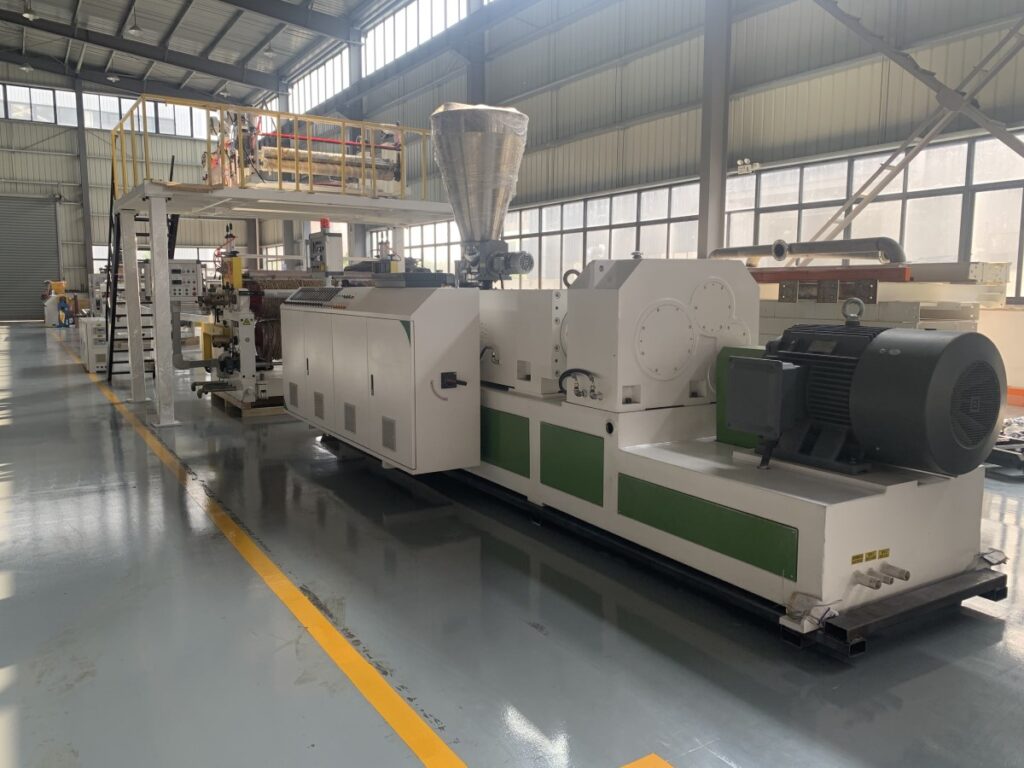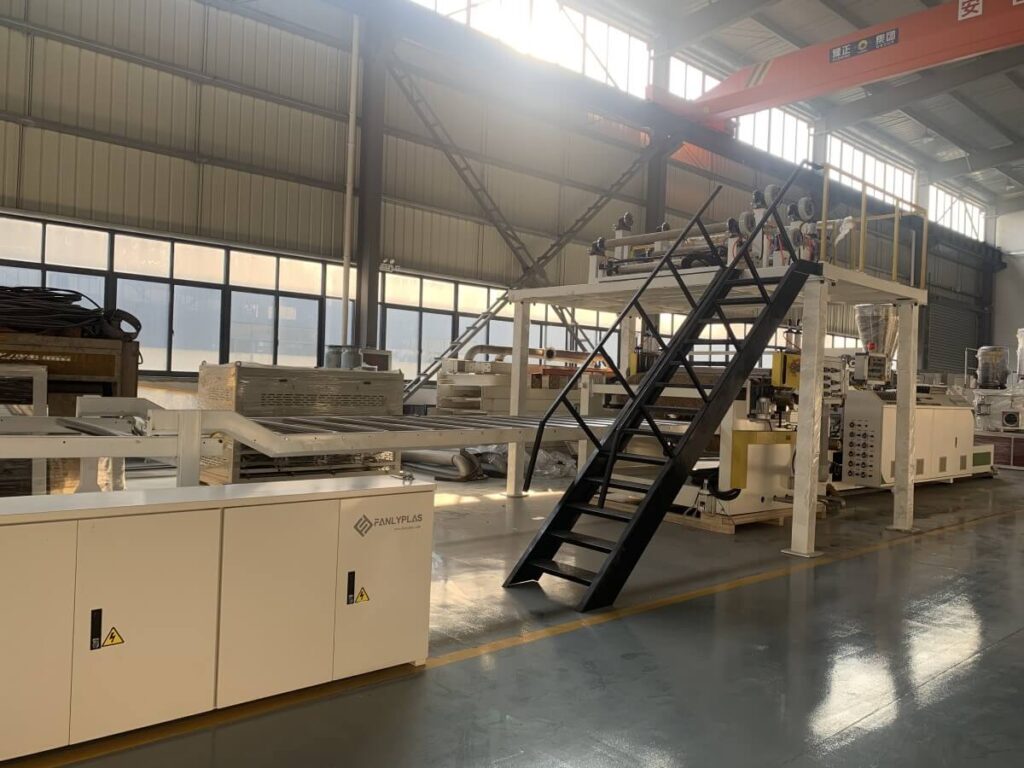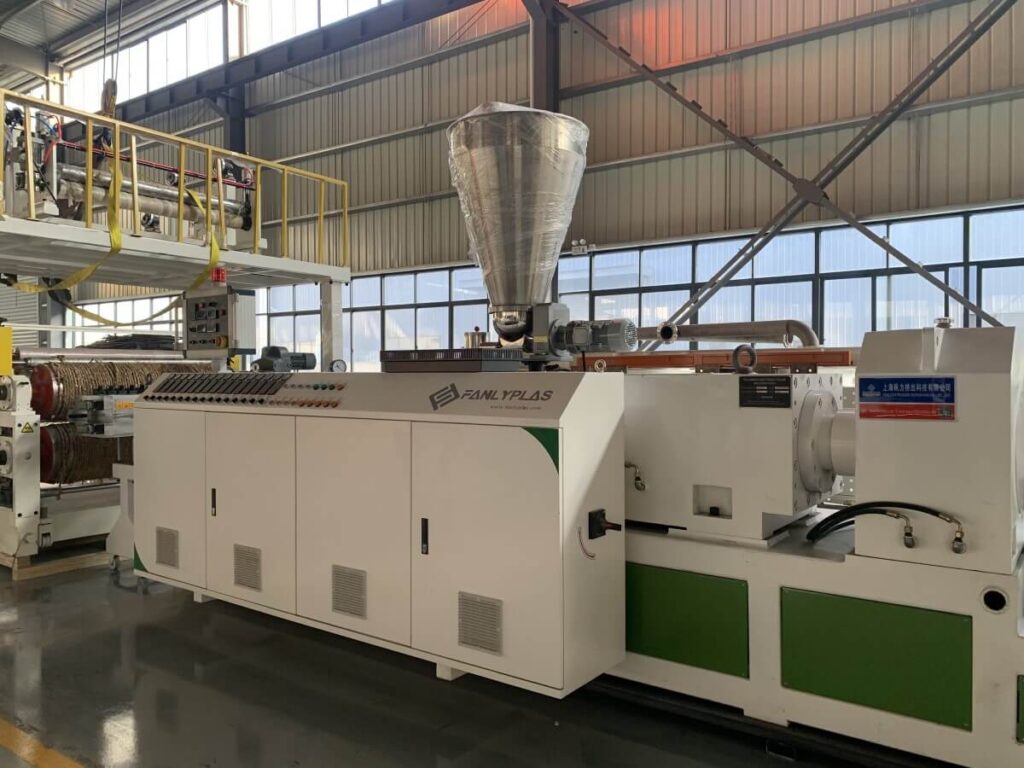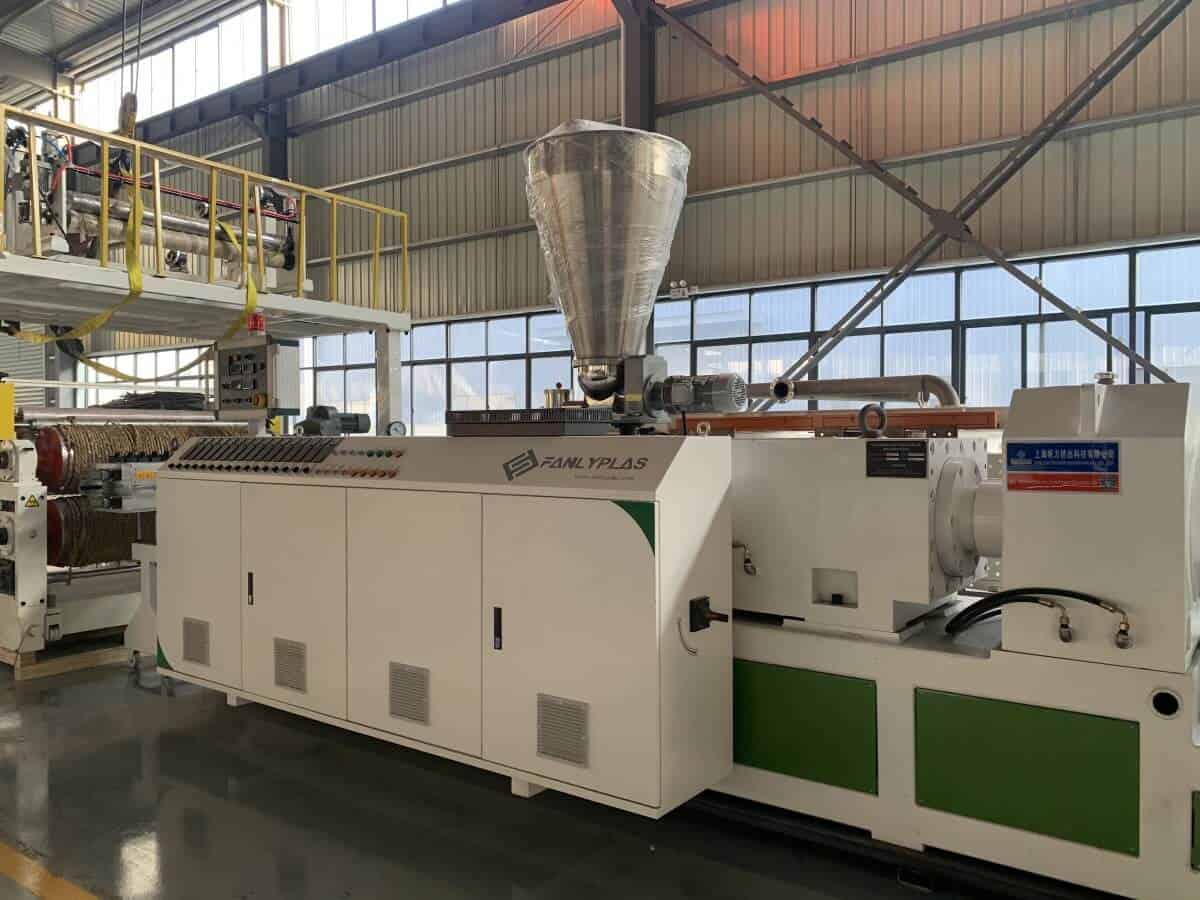Introduction
An SPC floor extrusion line uses advanced technology to produce sturdy flooring materials that combine limestone powder and PVC. If the production equipment is in good working order, you stand to enjoy optimized productivity and reduced operational costs.
Yet, regardless of the perfection in machine construction, it will still be prone to occasional breakdowns. Fortunately, knowing common problems and their exact sources can come in handy when troubleshooting or repairing the equipment. Like every other man-made equipment, the SPC floor production machine also encounters functional problems from time to time.
Before we highlight the challenges, it is crucial to partner with a dependable SPC floor extrusion line manufacturer like FANLYPLAS for top-notch machine quality. Our production lines are well-made with a guarantee of durability and minimal operational hitches.

That aside, we have compiled a list of common errors your production line is likely to encounter and possible ways to iron out the technicalities.
Dimensional Differences
A dimensional difference is all about irregularities that might arise in the size of the SPC flooring sheets. The problem comes from an improperly laid die, inconsistency in production temperatures as well as a poorly designed screw.
Solution
Every component of the extrusion line should be thoroughly checked to ensure it is in good working order. All variables including the cooling power, motor load, heating power, production line velocity, and melt pressure have to be consistent for top quality products.
External Impurities in SPC floor extrusion line
Another reason why your extrusion line may malfunction might be because of external impurities. It happens when the dead corners of your production machine are not thoroughly cleaned. When impurities from these corners get mixed into your raw materials then your production line is likely to malfunction. Apart from that, impurities can get into the equipment through open surface holes.
Solution
The best way out of external impurity-related malfunction is to clean up the dead corners perfectly. Other than that, try to add raw materials into the machine in tiny bits or rather screen the crushed raw material manually to get rid of the impurities.
Still, it is advisable to utilize more filter sheets and meshes to effectively eradicate impurities. Finally, use a net or solid cover to shield off holes through which debris might enter.
Aesthetic flaws
Aesthetic-related problems arise because of die lines, black specs, drag marks, tiny holes, and sink marks that show up on the surface of the SPC floor extrusion line. Aesthetic flaws contribute to impurity-related problems as they may allow foreign materials into the machine.
Solution
You have to take care of any aesthetic flaw that may alter the functionality of your production line. Cover any holes, drag marks, and so on to keep the equipment in top form.
Internal impurities
Impurities will not just come from the outside; the production line is also susceptible to internal impurities. It happens during the carbonization process. An awful amount of carbonization happens within the equipment.
When carbonized material is transferred to the material strip, the chances of the material strip being broken are super high. The chances of breakage are heightened by traction-related activities. Material strip extracts are the causes of internal impurities.
Solution
It is vital to constantly check the functional status of the material strip now and then to prevent unprecedented breakage. If the strip seems to be worn out, it should be replaced as soon as possible.
Inadequate plasticization of raw materials
Poor plasticization happens when raw materials fail to undergo full plasticization. Inadequate plasticization may also happen when big lumps appear in the material. If the screw shear turns out to be very weak or the extrusion temperature happens to be low, the same will happen.
When raw materials do not undergo complete plasticization, their composition becomes too inconsistent to get past the material strip. During the action of traction, the materials can break the strip or bar. In turn, broken bars or strips bring about impurities, which affect the quality of the output of the production line as well as its functionality.
Solution
To curb the incomplete plasticization of materials, you need to utilize additives that can lower the melting point and facilitate quick melting of the materials.
Other than that, you need to work on the extrusion temperature by adopting external heating sources to increase the extrusion temperature.
Finally, it is essential to rectify the screw shear by reducing the gap between the barrel and screw.
Variation in physical features of raw material
Now that you will be feeding raw materials of different physical and chemical properties into the extrusion machine, their reaction time or fluidity will be different as well. Because of incompatibility in fluidity, it brings out a mismatch in chemical reaction rates as well as a variation of physical entanglement.
All this happens through the phase separation that takes place during the injection molding process. If raw materials fail to change and react uniformly, it results in rigidity and hardness.
When the difference between the chemical and physical properties of the materials is too big, it will give the extrusion machine a hard time processing it. Increased viscosity is the biggest challenge at this point as it leads to poor plasticization.
Consequently, it will have a detrimental impact on the screw sheer, causing it to weaken and possibly break the strips.
Solution
To keep the change in viscosity between the blending components in check, it would be prudent lower the material speed at the main equipment screw. Additionally, you can find a way to increase the extrusion temperature to achieve complete plasticization
Inefficient exhaust or cooling system
Temperatures get quite high as the production line keeps working. As a result, the screw will overheat, which may cause the decomposition of flame retardants alongside other additives in the material.
Gas is also produced in the course of the process. If the vacuum fails to get rid of the gas in a timely fashion, it may be trapped within the strip and affect the traction as well. When the strip and traction are impacted, material bars will be impacted. That could lead to breakage.
Similarly, if the material is damp it produces water vapor. In case the vacuum and the natural exhaust system do not take care of the water vapor in time, it gets trapped within the material strip resulting in the deterioration of the strip.
Solution
If the gaskets are too high or there is some sought of air leakage, the vacuum, and natural exhaust will be inefficient. The same will happen in the event of blockages in the exhaust system. You need to realign the gaskets, seal out any air leakages, and clear blockages.
Screw wear
The screw-like any other part of the extrusion machine is prone to wear and tear. A lot of wear and tear on the screw takes place around the feeding area. This is a result of the rigidity of raw materials before undergoing the melting process. The problem is also facilitated by dry friction between the hard metal structures of the screw component and chip particles.
Solution
To avoid unexpected breakdown of the machine because of screw wear, you will have to keep a close eye on the performance of the extruder screw. Also, you need to increase the temperature in order to heat up the chip particles or raw material and soften it. Dry friction decreases when the raw materials are soft.
Abnormal noise
When your production equipment keeps producing abnormal noise, it could be an indication of poor lubrication or damaged bearings. The noise often comes from the gearbox although it could also be produced from other components.
Similarly, the abnormal noise may be a result of poor equipment installation. Improper meshing and poor gear adjustment could also explain the abnormal noise.
If the machine produces a sound that is sharp scraping, it might be because of a problem in the barrel. It happens when the barrel deviates and starts scraping the transmission sleeve or the head of the shaft.
Another noise-related problem that might face the barrel is a bent screw. When a bent screw keeps touching the bore, it makes abnormal noise. Still, if the temperature is set too low, it results in excessive friction within solid particles causing a lot of noise.
Solution
To eliminate the noise, you need to consider replacing the bearings. Likewise, you should improve the amount of lubrication in the machine for smooth running. Altering gear meshing conditions or changing gears would also be an excellent solution to the problem.
On the other hand, you can eliminate the sharp scraping noise by adjusting the barrel. If the noise is produced because of a bent screw, it can be eliminated by straightening it.
In case the noise comes from solid particles, you will have to adjust the set temperature to the right amount.
Abnormal vibration
If you feel any abnormal vibration emanating from the gearbox of your extrusion machine, there could be a small hitch in the functionality of the gears and bearings. The error is triggered when solid foreign substances get into the processing material. However, you need to check the extruder equipment to confirm that.
Solution
To iron out the vibration problem, you will have to replace the gears or bearings. Apart from that, you need a way to effectively filter out foreign materials that harm the bearing or gears.
The ultimate remedy for that is installing a dependable magnetic device within the hopper of your equipment to filter out iron fillings.
Unstable host current
An unstable host current is a production setback that is caused by the uneven feeding of raw materials. Moreover, it comes up in the event that the main motor bearing is poorly lubricated or severely damaged.
In a similar manner, your extrusion line is likely to experience the problem when the heater section of the machine fails to work.
Likewise, the host current will become unstable if the adjustment pad on the screw is done wrong or when the phase is not right leading to an inference in the components.
Solution
First, you have to check and troubleshoot the feeder. Together with that, take out the main motor and get another set of bearings into place. Next, confirm whether the heaters are working and replace the heaters that may be faulty.
Lastly, take a look at the adjustment pad. Take out the screw and confirm whether there is any form of interference within the screw component.
Malfunction in the main motor
The main motor of your extrusion line will malfunction in case of a hitch in the driving procedure. Additionally, the main motor might fail to work when there is an error within the main motor thread like a burnt fuse.
Another cause of a faulty main motor is the problem with the interlocking component linked to the main motor.
Solution
To correct the main motor problem, confirm the driving procedure then utilize the correct driving sequence.
If the problem is linked to the primary circuit, troubleshoot it and correct the error.
After that, look at the lubricating oil pump and confirm if the interlocking component of the main motor is in good working order. If the oil pump fails to run, the machine’s engine cannot run as well.
Another way to remedy the fault is to check whether the inverter’s induction current is okay.
Extreme primary starting current
There are several factors that might bring about an excessive increase in the starting current. The first attribute is insufficient torque.
Additionally, the primary current will get too high if the heating time is not sufficient. Your production equipment will also face the problem if a particular area of the heating system fails to work.
Solution
All you have to do to avoid a repetition of the fault is to increase the heating time. Other than that, regularly check if every section of the heater is fully functional.
Extreme temperature in main motor bearing
The main motor bearing will certainly experience extreme temperatures if there is insufficient lubrication in the bearing. It is owing to friction. Similarly, the main motor will get too hot if the bearing is out of working order or worn out.
Solution
Check the status of the motor bearing to confirm that it is in good working order. Find a replacement if it is worn out.
If that is not the case, ensure the bearing is adequately lubricated.
Unstable head pressure
Your production line equipment might encounter unstable head pressure when the primary motor’s rotation velocity is uneven. Another explanation for unstable head pressure is a fluctuation in the velocity of the feeding motor.
A fluctuation in the feeding motor’s speed brings about a fluctuation in the feeding amount.
Solution
The problem can be solved by checking the efficiency of the bearings as well as the central motor of the control system.
Along with that, troubleshoot the control system and make sure the feeding system motor is working correctly.
Low pressure in lubricating oil
Low pressure in the lubricating oil will occur if you set the pressure setting value of the valve that controls the lubricating oil pressure system low. The resultant pressure becomes too low to push the lubricating oil around the equipment.
Likewise, the error could be linked to a blocked oil suction pipe or a faulty pump.
Solution
To resolve the error, reset the pressure on the lubricating oil to a proper value.
Apart from that, get rid of foreign substances that may be blocking the oil suction pipe.
Blockage at the screw inlet
The production machine will malfunction if there is annular blockage impacting the screw inlet. The error leads to insufficient flow of cooling water or an interruption in the flow of cooling water.
Solution
Check if there is any material blocking the screw inlet and clean it thoroughly.
Blocked vacuum
The vacuum is designed to get rid of any excess moisture or gas produced during the extrusion process. If gas and moisture accumulate or get trapped in the strip due to vacuum blockage, it could break material bars.
Solution
Check if the vacuum is clear or use a fine iron wire to unlock it. Other than that, ensure that the vacuum pipeline has no leakage.
Inaccurate cutting length
When the cutting machine is not installed correctly or when some of its accessories are out of working order, it will result in inaccurate cutting lengths of SPC flooring sheets. Inaccurate lengths mean that you have to redo the process again to get it right. This will eventually result in material wastage.
Solution
You need to install and calibrate the cutting machine accurately. Apart from that, check if every component of the cutting machine is working correctly.
Start by looking at the long wheel bolts and make sure they are tight enough. The travel switch and the rotary encoder wiring system should also be functioning appropriately.

Maintenance Tips for Your SPC Floor Extrusion Line
Most of the errors above can be avoided if simple maintenance procedures like workshop tidiness are adopted. Here is a detailed rundown of crucial tips you can use to keep your production line in good working order:
Calibrate the equipment accordingly
It is important to keep an eye on equipment calibration. This helps to keep the quality of your output consistent. Variables like amperage, temperature, and pressure of different components in the production line machine should be monitored as well.
Maintain raw material consistency
Keep raw materials in a clean and dry place away from sudden temperature variation. It helps to eliminate the risk impurity contamination.
Cover the equipment after use
Covering the equipment will keep out dirt and other contaminants that could lead to unplanned downtime. The more you shield the machine from water, the less you worry about corroded components.
Condensation is especially a major challenge for the production line as it contributes to corrosion. Keeping out moisture will eliminate the deterioration of the equipment and ensure smooth SPC floor extrusion.
Employ preventative maintenance measures
You need to schedule preventative and proactive maintenance of the production line at regular intervals. Carrying out equipment maintenance when the machine is not in use will not just ensure consistent production but also curb unexpected breakdowns.
Proactive maintenance means keeping track of issues that come up and monitoring the functionality of all components. Primarily, keep a close eye on moving parts as they are more prone to wear due to constant friction.
Replace worn-out components
Rather than waiting until your components let you down during the production process, it may be wise to replace any worn-out parts in good time. Likewise, watch out for signs of wear and tear on the components.
Clean the equipment regularly
Sometimes, all a machine needs is a thorough cleaning. Keeping the production and your workplace tidy at all times keeps out any dirt or foreign components that might compromise the flawless functionality of the SPC floor extrusion line equipment.
Lubricate the equipment sufficiently
Lubrication is vital for any form of machine. A production line is a heavy machine that requires sufficient and constant lubrication. Given the magnitude of the equipment, its moving parts will likely incur a lot of friction. Lubrication helps to alleviate component damage and keep corrosion in check.
Keep your workplace clean and organized
Keeping a clean production line in a dirty workshop is useless. Tidiness should be applied to both the SPC floor extrusion line and the entire workshop as well. Cleaning everything thoroughly gets rid of unwanted debris and other material that might affect the production equipment negatively.
Monitoring devices, sight glasses, and other electronics should be dry and dirt-free at all times. On top of that, an organized workplace makes it easy to carry out maintenance exercises and helps to create space.

Conclusion
The goal of any SPC floor extrusion company should be to ensure customer satisfaction and have a competitive or productive advantage over other rivals. It can be difficult to attain such ambitious expectations when the production line keeps malfunctioning. We hope that our article will provide a clear roadmap for identifying and rectifying problems in your SPC floor extrusion line.


